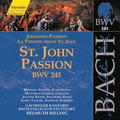
$6.99
 
|
UNLIKE BACH HIMSELF, most of us come to the Saint John Passion knowing the Saint Matthew Passion first. The bigger and more elaborate Saint Matthew, which came along three, or possibly five years later (there is controversy about the date), has tended to cast a shadow in which the earlier work is swallowed up, and this has been so ever since Mendelssohn's Saint Matthew performance in 1829 marked the beginning of the public rediscovery of J.S. Bach. (The professionals had never forgotten.) But if the Saint John is smaller in scale than the Saint Matthew, it is hardly the lesser work in quality, though it would of course be silly to claim that the master of the Saint Matthew Passion had not learned from the experience of setting Saint John. But the most interesting differences between these two towering attestations of faith are differences in intention. Read Matthew 26-27, Mark 14-15, Luke 22-23, and John 18-19, and you get four tellings of the last days in the life of Jesus that differ in tone, emphasis, and detail. Much of what gives Bach's Saint John Passion its special character, of those qualities that make it a work even more deeply cherished by many who know it well, can be traced to the character of the fourth gospel itself.
For us, the Saint John is the first of Bach's two Passion settings. But the long obituary of Bach written in 1754 by his son Carl Philipp Emanuel with the help of Johann Friedrich Agricola, one of Bach's pupils, mentions five such works. This is a mystery probably now past unraveling, but our best guess is this: 1. At some point while he was in Weimar, where he was appointed organist in 1708 and Concertmeister in 1714, Bach wrote a Passion, now lost. A few movements in the Saint John and Saint Matthew Passion do seem to go back to that period, and they may be the only surviving portions of that putative Weimar Passion. 2. The Saint John Passion of 1724 (and its various revisions). 3. The Saint Matthew Passion of 1727 or 1729. 4. A Saint Luke Passion. This survives in a manuscript from about 1730 that is partly in Bach's hand, though the music is certainly not his own. Presumably Bach performed it, or intended to perform it, in Leipzig. C.P.E. Bach and Agricola may have mistaken it for a work of Bach's and thus included it in their census. Of course, given his delight in exhaustive cycles, Bach should have composed a Saint Luke Passion. 5. The Saint Mark Passion of 1731, all of whose text and some whose music survive. The complete score was last seen in 1764.
|
